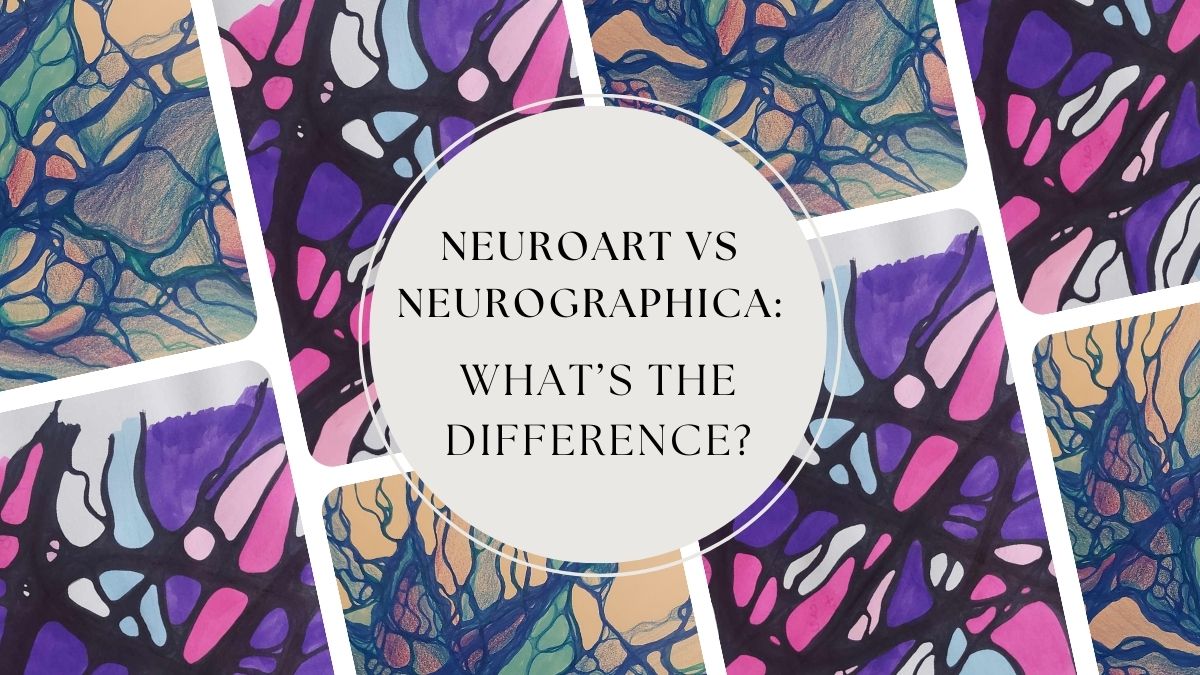Neuroart vs Neurographica: What's the difference?

Learn about the difference between Neurographica and Neuroart and which is the best fit for what you're after.
Ever find yourself doodling during a long meeting or while on hold, and suddenly you feel calmer?
That’s not just a distraction—it’s your brain’s way of processing, releasing, and resetting. And guess what? You can tap into that same magic on purpose with mindful drawing.
Today, I want to chat about the difference between two similar and powerful creative practices—Neuroart and Neurographica—and how they help shift your mindset in different ways.
What is Neuroart?
Neuroart is your creative free space. No rules. No structure. Just you, your pen (or whatever you feel like using), and the present moment. Ever notice how your breathing slows and your shoulders drop when you’re drawing without thinking? That’s Neuroart doing its thing.
You can use whatever supplies you want from watercolor to crayons, and can create whatever you like. It's about the process- getting lost in the moment and letting your mind unwind, but also results in beautiful artwork.
What is Neurographica?
Neurographica takes that same creative energy and gives it direction and purpose, which I think is one of the main reasons I'm drawn to it (pun intended).
Neurographica was created by psychologist Pavel Piskarev, it’s an intention-driven method designed to help you actually shift your mental patterns. Think of it like a guided journaling session—but with lines, shapes, and color instead of words and reflecting as you make your way through the process.

If Neuroart is a slow, meandering walk through the woods, Neurographica is a guided trail that leads to big “aha” moments. Both are powerful, just in different ways.
So what are the key differences?
Neuroart = Exploration & Presence (Great When You…):
✔️ Need to decompress and quiet your mind
✔️ Want to connect with your feelings without overanalyzing them
✔️ Crave a creative outlet without too much pressure or structure
✔️ Just need a mental “pause” from everything
Neurographica = Transformation & Insight (Perfect When You…):
✔️ Are working through a specific challenge
✔️ Want to shift your perspective on something
✔️ Need help uncovering deeper patterns in your thinking
✔️ Are looking for structured guidance to find clarity

How to Practice Both
Neuroart:
✨ Find a quiet moment (or don’t—this works anywhere!)
✨ Grab a pen and some paper
✨ Take a few deep breaths to settle in
✨ Let your hand move however it wants—no plan, no pressure
✨ Notice how your body feels as you draw
✨ Observe without judgment—just be with it
You may end up drawing a recognizable picture using Neuroart, and coloring it or painting it, however you want. It's about how you feel and enjoying the process.
Neurographica:
🖊️ Start with an intention or question in mind
🖊️ Add intersecting lines and shapes that represent your thoughts, connecting and weaving through
🖊️ Round out any sharp angles
🖊️ Add color
🖊️ See what insights emerge as you go
The thing with Neurographica is that there is an actual algorithm that we move through with every drawing. A step of steps, designed to get you the shifts in your life that you want. Unlike Neuroart, Neurographica does have rules that we follow in terms of the lines and how we add color.
It's very much about the process (you'll feel more relaxed and there's definitely a huge mindful, reflective component). But it's the rules and steps that allow for the shift to occur during and after the drawing process.
So, we're not drawing, just to draw and enjoy (like Neuroart). But we are trying to get a result.
Which one is better?
I found Neuroart first and loved it. I didn't know the difference between Neuroart and Neurographica in the beginning, because they looked so similar.
But once I discovered that there is an algorithm, my love of structure, self-development, and goal setting made Neurographica a perfect fit for me - to the point where I wanted to become certified in the method to share it with others (which I did).
Both practices bypass overthinking and tap into a different kind of knowing—the kind that doesn’t need logic to make sense. Both are great to build your intuition and really force you into being present and recognizing what that feels like.
Whether you’re feeling stuck, stressed, or just need a reset, both methods offer a simple (and honestly, kinda magical) way to shift gears.
Which One is Right for You?
Don't worry - you don’t have to choose! Some days, you might want to play with watercolor and you want the open-ended flow of Neuroart.
Other days, you might crave the deeper insights of Neurographica, with a goal and a shift in mind.
Both offer a way to tune into yourself, get unstuck, and feel more at ease and present.
So… have you tried either one? Which speaks to you more? I’d love to hear about your creative journey.

P.S. Fancy art supplies? Totally optional. Your favorite pen and the back of a receipt work just as well when you want that moment of mindfulness. 😉 It’s about the process, not the product.
Categories: : Neurographica Basics
 Krystal Mills
Krystal Mills 